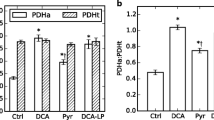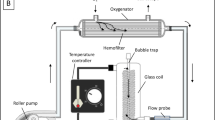Abstract
Fructose-1,6-bisphosphate (FBP) helps preserve heart and other organs under ischemic conditions. Previous studies indicated that it can be taken up by various cell types. Here we extended observations from our group that FBP could penetrate artificial lipid bilayers and be taken up by cardiac myocytes [8, 10], comparing the uptake of FBP to that of L-glucose. Using liposomes prepared by the freeze-thaw method, FBP entered about 200-fold slower than L-glucose. For liposomes of either soybean or egg lipids, 50 mM FBP enhanced the permeability of FBP itself, with little effect on general permeability (measured by uptake of L-glucose). In experiments with isolated cardiac myocytes at 21°C, FBP uptake exceeded the uptake of L-glucose by several fold and appeared to equilibrate by 60 min. There was both a saturable component at micromolar levels and a nonsaturable component which dominated at millimolar levels. The saturable component was inhibited by Pi and by other phosphorylated sugars, though with lower affinity than FBP. Both saturable and nonsaturable uptakes were also observed at 3°C. The results indicate that FBP enters myocytes not by simple penetration through the lipid bilayer, but via at least two distinct protein-dependent processes. The uptake could lead to intracellular effects important in hypothermic heart preservation.
Similar content being viewed by others
References
Niu W, Zhang F, Ehringer W, Tseng M, Gray L, Chien S: Enhancement of hypothermic heart preservation with fructose 1,6-diphosphate. J Surg Res 85: 120-129, 1999
Chien S, Zhang F, Niu W, Ehringer W, Chiang B, Shi X, Gray LA: Fructose-1,6-diphosphate and a glucose-free solution enhances functional recovery in hypothermic heart preservation. J Heart Lung Transplant 19: 277-285, 2000
Hua D, Zhuang X, Ye J, Wilson D, Chiang B, Chien S: Using fructose-1,6-diphosphate during hypothermic rabbit-heart preservation — a high-energy phosphate study. J Heart Lung Transplant 22: 574-582, 2003
Kelleher JA, Chan PH, Chan TYY, Gregory GA: Energy metabolism in hypoxic astrocytes: Protective mechanisms of fructose-1,6-bisphosphate. Neurochem Res 20: 785-792, 1995
Hassinen IE, Nuutinen EM, Ito K, Nioka S, Lazzarino G, Giardina B, Chance B: Mechanism of the effect of exogenous fructose 1,6-bisphosphate on myocardial energy metabolism. Circulation 83: 584-593, 1991
Galzigna L, Rizzoli V, Bianchi M, Rigobello MP, Scuri R: Some effects of fructose-1,6-diphosphate on rat myocardial tissue related to a membrane-stabilizing action. Cell Biochem Function 7: 91-96, 1989
Cavallini L, Dana R, Francesconi MA, Alexandre A: Fructose-1,6-diphosphate inhibits platelet activation. Biochem Pharmacol 43: 1539-1544, 1992
Ehringer WD, Niu W, Chiang B, Wang O-L, Gordon L, Chien S: Membrane permeability of fructose-1,6-diphosphate in lipid vesicles and endothelial cells. Mol Cell Biochem 210: 23-45, 2000
Ehringer WD, Su S, Chiang B, Stillwell W, Chien S: Destabilizing effects of fructose-1,6-bisphosphate on membrane bilayers. Lipids 37: 885-892, 2002
Ehringer WD, Chiang B, Chien S: The uptake and metabolism of fructose-1,6-diphosphate in rat cardiomyocytes. Mol Cell Biochem 221: 33-40, 2001
Colston VL, Wheeler TJ: Stimulation of cardiac glucose transport by inhibitors of oxidative phosphorylation. Life Sciences 69: 2383-2398, 2001
Rett K, Wickimayr M, Dietze GJ, Häring HU: Insulin-induced glucose transporter (GLUT1 and GLUT4) translocation in cardiac muscle tissue is mimicked by bradykinin. Diabetes 45(suppl 1): S66-S69, 1996
Wheeler TJ, Cole D, Hauck MA: Characterization of glucose transport activity reconstituted from heart and other tissues. Biochim Biophys Acta 1414: 217-230, 1998
Kasahara M, Hinkle PC: Reconstitution and purification of the D-glucose transporter from human erythrocytes. J Biol Chem 252: 7384-7390, 1977
Fischer Y, Rose H, Kammermeier H: Highly insulin-responsive isolated rat heart muscle cells yielded by a modified isolation method. Life Sci 49: 1679-1688, 1991
Beutler H-O: D-Fructose. In: H.U. Bergmeyer (ed). Methods of Enzymatic Analysis, vol 6, 3rd ed. Verlag Chemie, Weinheim, 1984, pp 321-327
Cornell NW, Leadbetter MG, Veech RL: Modifications in the enzymatic assay for inorganic phosphate. Anal Biochem 95: 524-526, 1979
Wheeler TJ, Hauck MA: Reconstitution of the glucose transporter from bovine heart. Biochim Biophys Acta 818: 171-182, 1985
Hardin CD, Giardina B, Tavazzi B, DiPierro D, Lazzarino G, Galvano M, Rovetto MJ: Transport mechanism of fructose 1,6-bisphosphate in isolated rat hearts. J Mol Cell Cardiol 30: A62, 1998
Lazzarino G, Cattani L, Costrini R, Mulieri L, Candiani A, Galzigna L: Increase of intracrythrocytic fructose-1,6-diphosphate after incubation of whole human blood with fructose-1,6-diphosphate. Clin Biochem 17: 42-45, 1984
Gregory GA, Yu ACH, Chan PH: Fructose-1,6-bisphosphate protects astrocytes from hypoxic damage. J Cereb Blood Flow Metab 9: 29-34, 1989
Hardin CD, Roberts TM: Metabolism of exogenously applied fructose 1,6-bisphosphate in hypoxic vascular smooth muscle. Am J Physiol 267: H2325-H2332, 1994
Juergens TM, Hardin CD: Fructose-1,6-bisphosphate as a metabolic substrate in hog ileum smooth muscle during hypoxia. Mol Cell Biochem 154: 83-93, 1996
Tavazzi B, Starnes JW, Lazzarino G, DiPierro D, Nuutinen EM, Giardina B: Exogenous fructose-1,6-bisphosphate is a metabolizable substrate for the isolated normoxic rat heart. Basic Res Cardiol 87: 280-289, 1992
Takeuchi K, Cao-Danh H, Friehs I, Glynn P, D'Agostino D, Simplaceanu E, McGowan FX, del Nido PJ: Administration of fructose 1,6-diphosphate during early reperfusion significantly improves recovery of contractile function in the postischemic heart. J Thorac Cardiovasc Surg 116: 335-343, 1998
Williams JP, Headrick JP: Differences in nucleotide compartmentation and energy state in isolated and in situ rat heart: Assessment by 31PNMR spectroscopy. Biochim Biophys Acta 1276: 71-79, 1996
Wheeler TJ: Translocation of glucose transporters in response to anoxia in heart. J Biol Chem 263: 19447-19454, 1988
Author information
Authors and Affiliations
Rights and permissions
About this article
Cite this article
Wheeler, T.J., McCurdy, J.M., denDekker, A. et al. Permeability of fructose-1,6-bisphosphate in liposomes and cardiac myocytes. Mol Cell Biochem 259, 105–114 (2004). https://doi.org/10.1023/B:MCBI.0000021356.89867.0d
Issue Date:
DOI: https://doi.org/10.1023/B:MCBI.0000021356.89867.0d




